Harvesting Water (and Power) from Air

Air Well
Ancient water harvesting
structure utilizing condensation, Trans-en-Provence, France.
An air well collects water by promoting the condensation of moisture from the air. Evidence of air wells has been found in the Byzantine city of Theodosia, and there are three methods that have been used to create the condensation necessary for the production of useful quantities of water. High mass collectors are air wells that use the benefit of constructions with a thermal mass to create temperature variation suitable for the production of condensation.
High mass wells are the oldest and simplest form of air wells. Radiative air wells use panels heated by sunlight to create condensation, and active collection air wells use heat pumps to remove moisture actively from air, similar to the way a dehumidifier functions. Active collection wells are energy intensive, however there is ongoing research into creating more efficient active air wells to harvest water from the air.
Self-Filling Water Bottle Concept Harvests H20 From Air
Did you know that there are more than three quadrillion gallons of water just floating around in the air? Climate change has made it abundantly clear that water will become an even more precious resource in the coming decades. Although the freshwater rivers and lakes from which we source drinking water may dry up, scientists hope that advanced technology will allow them to harvest this atmospheric water as a new supply.
We’ve already reported on a wind turbine concept that plucks water from desert air [see below], but that’s hardly a practical investment for your average individual. Now, new developments from a company called NBD Nano suggests this technology may be in our hands sooner than previously thought. The company has pioneered a water bottle that can refill itself with drinkable water harvested from the air.

Image via Muffet/Flickr
“Every morning this beetle climbs to the top of a sand dune, sticks its back to the wind, and drinks 12 percent of its weight in water,” said NBD cofounder Deckard Sorensen in an interview with PRI. “We use nanotechnology to mimic this beetle’s back so that we too can pull water from the air.” In the novel design, the water bottle’s surface is coated with hydrophilic and hydrophobic coatings, and then a fan is used to pass air over the surface. The water condenses on the surface and, eventually, the water bottle refills itself. The design could operate using a rechargeable battery or solar cell to speed-up accumulation and filter the water.
Obviously, this technology could have a huge impact, especially in developing nations where other types of water filtration are hampered by a lack of infrastructure. NBD hopes to bring this off-grid water bottle to market by 2014.
Wind turbine creates water from thin air
By Eoghan Macguire
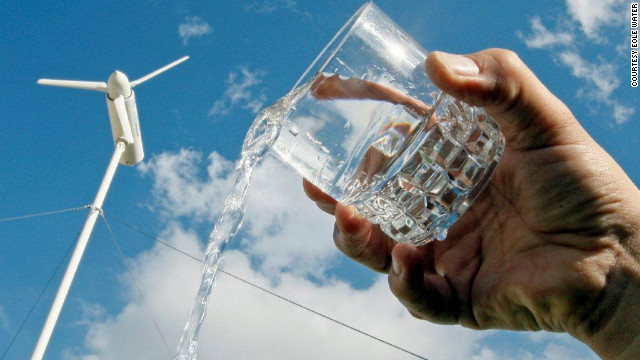
Water from thin air
Eole Water claims to have
successfully modified the traditional wind turbine design to create the WMS1000, an appliance that can manufacture drinking water
from humid air.
The
company aims to start rolling out the giant products for sale later in 2012,
initially focusing on remote communities in arid countries where water
resources are scarce.
"This
technology could enable rural areas to become self-sufficient in terms of water
supply," says Thibault Janin, director of marketing at Eole Water.
"As
the design and capabilities develop, the next step will be to create turbines
that can provide water for small cities or areas with denser populations,"
he adds.
Eole
Water is currently displaying a working prototype of the 24 meter tall WMS1000
in the desert near Abu Dhabi that has been able to produce 62 liters of water
an hour, says Janin.
One
turbine can produce up to 1,000 liters of water every day, depending on the
level of humidity
Thibault Janin
Thibault Janin
He
explains that the technology works by first generating electricity in the
traditional manner of a wind turbine. This power enables the entire water
generating system to function.
The
next stage sees air sucked in through the nose of the turbine via a device
known as an "air blower".
All
air trapped during this procedure is then directed through an electric cooling
compressor situated behind the propellers. This contraption extracts humidity
from the air, creating moisture which is condensed and collected.
The
water gathered at this stage is then transferred down a series of stainless
steel pipes, which have been specially modified to aid the water production
process, to a storage tank in the base of the turbine.
Once
there, the water is filtered and purified before it is ready for use and
consumption.

One
turbine can produce up to 1,000 liters of water every day, depending on the
level of humidity, temperature and wind speeds, says Janin.
"This
is enough to provide water for a village or town of 2,000 to 3,000
people," he adds.
Janin
highlights isolated communities in Africa and South America as well as remote
islands in Asia that have little or no access to safe drinking water as
potential beneficiaries of the technology.
"If
you think of Indonesia, it has (thousands of) islands and they cannot
centralize their water supply ... the geographic makeup of the country makes it
impossible," says Janin.
"This
technique could enable them to overcome these problems and make the islands
self-sufficient in a way that doesn't harm the environment."
But
while enthusiastic about the potential of his company's technology, Janin
admits that the initial costs of the turbines could be prohibitive, especially
for poorer towns or regions.
Just
now it costs between €500,000 ($660,000) and €600,000 ($790,000) depending on the location and surrounding
conditions to install just one Eole Water turbine.
As
time progresses and as an industrial process is developed that enables the
company to take advantage of economies of scale, this outlay is likely to fall,
says Janin.
"We
have just started the commercial aspect of this product but the price is not
that expensive when you compare it with the long term solution that it
gives," he adds.
Interesting ways to harvest water
from air
Every life form present on this blue planet needs water for survival. That’s the reason we see environmentalists over the world encouraging individuals to save every drop, as those precious drops might be what someone is desperately in need for. Since many potable water sources are contaminated, there are some designers who’re looking toward humid air to quench the thirst of millions. Here are some of the best devices that harvest fresh water from thin air:
• Max Water:
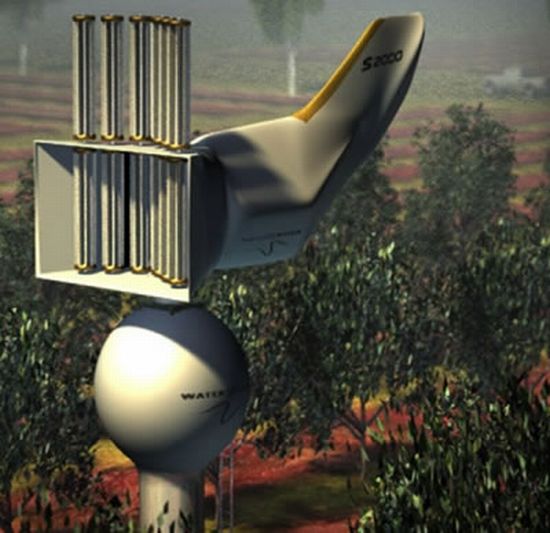

An Australian inventor has developed a device that is capable of harvesting unlimited water from air. Powered by wind, the device uses the same source for water as well. Dubbed Max Water, the system according to the inventor would even harvest significant amounts of water using air with low humidity. A four-meter square device could extract an average 7,500 liters of water a day.
• Watermill:
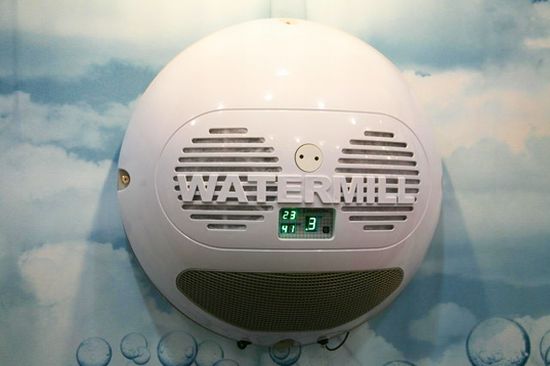

Developed by Element Four, the Watermill generates and then filters water so that what comes out of it is fit for consumption. The company promises that their device will be able to generate about 3.2 gallons of fresh drinking water a day in ideal conditions that should be enough for a family of six.
• Ersa:


The Ersa by industrial designer Scott Norrie is designed as a standalone, sustainable product that uses solar energy to create water from air. The design also uses the onboard solar panels to power handheld devices and trickle-charge a vehicle’s battery.
• EcoloBlue:
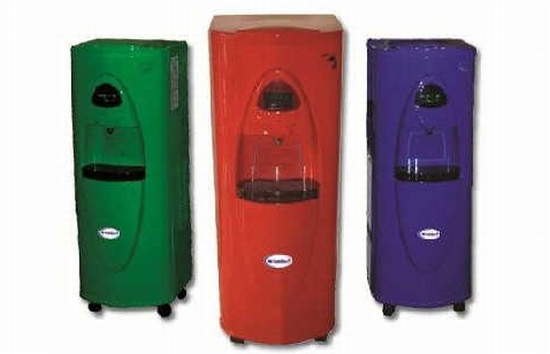

The EcoloBlue Atmospheric Water Generator (AWG) provides you with up to 7 gallons of clean water each day, provided the air around you is humid. The company developing the product states that it works best at 50 percent humidity, but can also work in humidity levels as low as 30 percent. If, however, the air isn’t humid enough, you can always hook it up to a tap water source so your drinking water is still filtered. The EcoloBlue costs $1,350 and the average operating cost stands at just 20 cents for every gallon of clean water.
• RainCloud C-15:
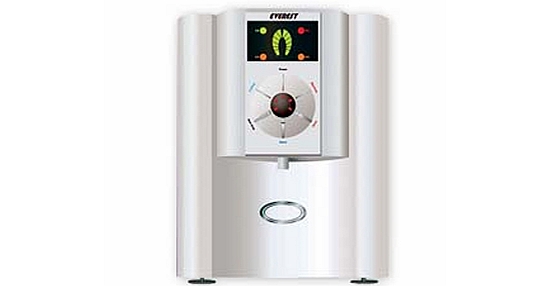

Cleanworld Ltd. has developed the RainCloud system, which is a dehumidifier with a built-in water purification system. The device harvests potable water from humid air and can also heat or cool the water for you to either have a nice chilled glass of water or a cup of tea.
• Dew Drop:
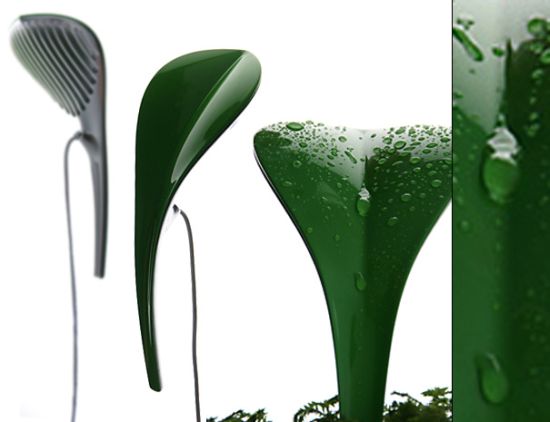

Industrial designer Jacky Wu has designed the Dew Drop device that extracts water from thin air for plants. The Dew Drop works on the principles of condensation. All the user has to do is to plant the artificial leaf in the same pot as the plant and connect it to a wall plug. Water condenses on the leaf and is fed to the plants.
• DropNet:
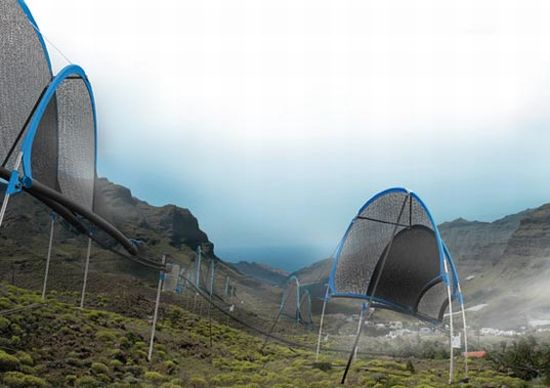

Industrial design student at Germany’s Muthesius Academy of Fine Arts and Design, Imke Hoehler, has created a system that harvests potable water from thin air and mist. Dubbed theDropNet, the water-collecting system can harvest up to 20 liters of clean water each day, and an array of several structures could supply a whole village with potable water.
• Groasis Waterboxx:
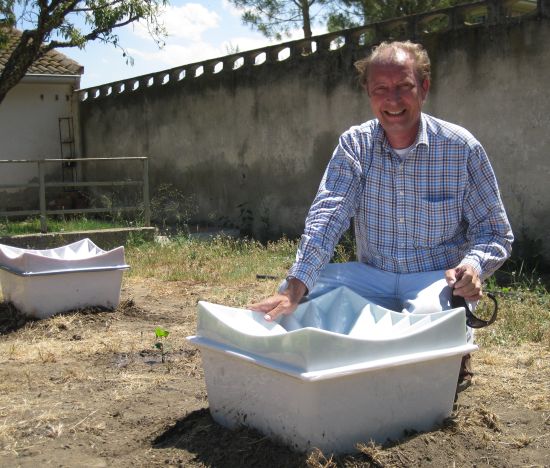

Created by Dutch entrepreneur Pieter Hoff, the Groasis Waterboxx can produce fresh water even in the driest places on earth. Inspired by bird poop, the device is modeled after the way excrement protects seeds that birds have digested, providing humidity and shelter from the elements so that they can grow. The 20-inch by 10-inch box surrounds the young plant and at night an insulation plate allows it to harvest water through condensation.
• Solar-powered system to generate potable water:


Research scientists at the Fraunhofer Institute for Interfacial Engineering and Biotechnology IGB believe that at an average 64 percent humidity, a cubic meter of air carries about 11.5ml of water, which if extracted can solve the problems of billions of people living in rural areas. The system makes use of hygroscopic brine that absorbs moisture. When this solution is made to run down a tower-shaped unit, it sucks up water from the air, which is then fed into a tank where vacuum prevails. Solar energy then heats up the solution converting water to vapor, which is then condensed and collected.
• Water Building Resort:
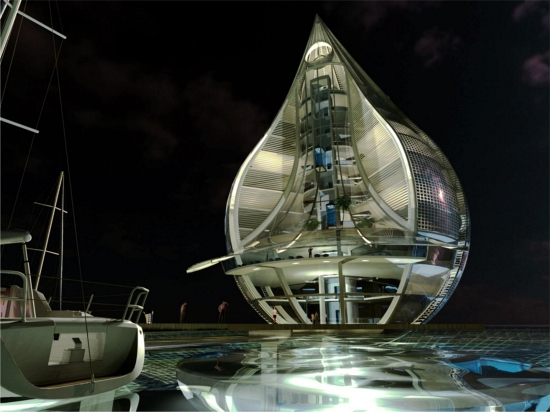

This may not be the portable water-producing device that you are looking for, but this beautiful conceptual resort is designed to answer similar issues. Conceived by Orlando de Urrutia, the Water Building Resort will make use of the best in technology to generate solar electricity, water from air and will also make sea water potable.
From http://earthtechling.com/2012/11/self-filling-water-bottle-concept-harvests-h20-from-air/ and http://edition.cnn.com/2012/04/29/world/eole-water-turbine/index.html
Perhaps now it's easier to understand how a single tree with acres of surface area for condensation - leaves -can create extra water, and why cutting forests is the surest way to create local and global deserts. - N.I.
For more information about wind power see http://nexusilluminati.blogspot.com/search/label/wind%20power
- See ‘Older Posts’ at the end of each section
You Can Help This Unique Independent
Site’s Author Survive
Donate any amount and receive at least one New Illuminati
eBook!
Please press the button -
For further
enlightening information enter a word or phrase into the random synchronistic search
box @ http://nexusilluminati.blogspot.com
And see
New Illuminati – http://nexusilluminati.blogspot.com
New Illuminati on Facebook - https://www.facebook.com/the.new.illuminati
New Illuminati Youtube
Channel - http://www.youtube.com/user/newilluminati/feed
The Her(m)etic Hermit -
http://hermetic.blog.com
The Prince of Centraxis - http://centraxis.blogspot.com
(Be Aware! This link leads
to implicate & xplicit concepts & images!)
This
site is published under Creative Commons Fair Use Copyright (unless an
individual item is declared otherwise by copyright holder) – reproduction for non-profit use is permitted & encouraged, if you give attribution to the work
& author - and please include a (preferably active) link to the original
along with this notice. Feel free to make non-commercial hard (printed) or
software copies or mirror sites - you never know how long something will stay
glued to the web – but remember attribution! If you like what you see, please
send a small but heartfelt donation or leave a comment – and thanks for reading
this far…
Live
long and prosper!
From the
New Illuminati – http://nexusilluminati.blogspot.com
To complement the information here...
ReplyDeleteAs the exciting field of drinking-water-from-air technologies evolves, there is a clear need for accurate scientific information useful to scientists, engineers, entrepreneurs, manufacturers, marketers, distributors, and consumers.The Atmoswater Research website (www.atmoswater.com) has organized information enabling quick and easy discovery of articles, patents, projects, and links to equipment sellers. Frequently asked questions are answered.
rain harvest solutions has to be executed in a alternative way so that it not only increases water use efficiency but also raises agricultural productivity and production and brings sustainability in the irrigated agriculture in a participatory environment.
ReplyDeletewhy you must regard including a hvac repair armonk vacuum pump in your armory of HVAC fixing tools. HVAC here stands for Heating, Ventilation, and Air Conditioning.
ReplyDelete